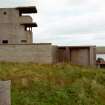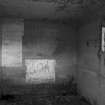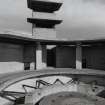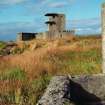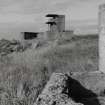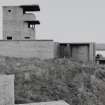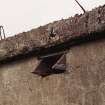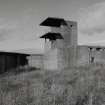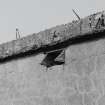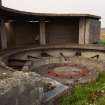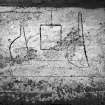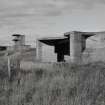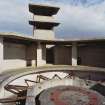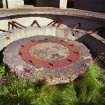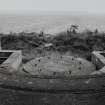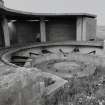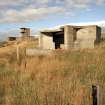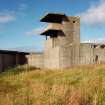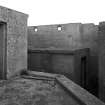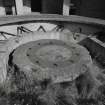Flotta, Innan Neb, Neb And Gate Batteries
Coastal Battery(S) (Second World War), Coastal Battery (First World War)
Site Name Flotta, Innan Neb, Neb And Gate Batteries
Classification Coastal Battery(S) (Second World War), Coastal Battery (First World War)
Canmore ID 81729
Site Number ND39SW 41
NGR ND 3499 9231
Datum OSGB36 - NGR
Permalink http://canmore.org.uk/site/81729
- Council Orkney Islands
- Parish Walls And Flotta
- Former Region Orkney Islands Area
- Former District Orkney
- Former County Orkney
The final decision to make Scapa Flow the main base for the Grand Fleet in the event of war (over the Invergordon dockyard in the Firth of Cromarty) was made only on the eve of war. As a consequence, in August 1914, the anchorage was undefended. It was only in mid-1915 that the anchorage was secured by guns, anti-submarine booms and blockships. In the end there were 13 batteries around the approaches to Scapa Flow.
The southern entrance to Scapa Flow, through Hoxa Sound to the east of Flotta, was the main one, and the busiest. The smaller entrance, to the west of Flotta, was also used, and was protected by an anti-submarine boom, with covering guns. The Innan Neb battery was positioned on the northern side of the channel.
The battery was equipped with two 4.7-inch Quick Firing guns, intended to engage smaller, fatser-moving vesels than the 6-inch guns covering Hoxa Sound. It was also provided with three Defence Electric Lights, powerful searchlights to illuminate targets for the guns at night.
The battery position was re-used in the Second World War, but new gun emplacements were built, leaving the First World War structures untouched.
Information from HS/RCAHMS World War One Audit Project (GJB) 25 September 2013.
ND39SW 41.00 3499 9231
See also sheet for E part of site
41.01 ND 3472 9246 Coast Battery (Innan Neb, WWI)
41.02 centred ND 3490 9262 Water Tank
41.03 ND 3499 9246 Engine House
41.04 ND 3498 9231 Searchlight Battery
41.05 ND 3508 9241 Engine House
41.06 ND 3474 9245 and ND 3476 9242 Coast battery (Gate, early WWII)
41.07 ND 3486 9250 Coast Battery (Innan Neb, WWII)
41.08 ND 3503 9233 Coast Battery (Neb, WWII)
ND39SW/SE 41.09 ND 3499 9231 and ND 3509 9236 Coast Battery (Gate, late WWII)
41.10 centred ND 3513 9253 Military Camp
Gate Battery: A WWII open gun emplacement, guns removed in 1945, on the site of a World War One battery (See ND39SW 41.01).
Neb Battery (ND39SE): 12 pounder gun emplacement with magazine, two 6pdr gun-emplacements, shelter, observation tower, engine room and searchlight platforms. The guns were removed in 1950.
J Guy 1993; NMRS MS 810/2; WO/192/259 PRO.
A group of coast batteries with a complicated history, the names given to World War I and World War II emplacements were the same, but not necessarily in the same position. In World War II, the same name was given to two batteries, one early and one late, in different locations.
Information from RCAHMS (DE), November 2000
Field Visit (1997)
WWI & II Innan Neb, WWII Gate battery and Neb battery: (ND39SW 41, 50) 1915-1918, 1940-1944.
Elements located
The Innan Neb Battery was originally constructed in 1915 to provide cover from the southern approach to Scapa Flow, via Switha Sound. Two 4.7 Quick Fire guns were emplaced and a boom was erected, running from Innan Neb to South Walls o n the island of Hoy. In 1940 it was brought back into use with the temporary emplacement of a 4.7 quick gun. This battery now served as a support for the new batteries at Neb and Gate. It was abandoned in 1944.
Gate battery was set up with the temporary installation of a single twelve-pounder gun in 1940. A second twelve-pounder was added, and later on, both guns were relocated to new concrete gun houses. This battery had the task of guarding the access point through the boom. Operations were ceased in 1945.
The Neb Battery comprised a twin six-pounder emplacement with a directing tower. It became operational in 1940 and continued in use up until the end of the war. It was charged with providing anti-motor-torpedo-boat protection.
All three batteries are located close together, in fact, the two gun emplacements of the Gate battery are located to either side of the Neb battery. This, together with the overgrown nature of the site, makes it difficult to separate the various structures associated with each battery illustrated on the accompanying plan. [Note: There is no plan in the manuscript]
(i)This semi-subterranean rectangular structure is probably a magazine. It measures 10m by 5m, lies 2m form the cliff edge and is much obscured by vegetation.
(ii) Two semi-subterranean rectangular bunkers lie to either side of a raised concrete plinth. This structure served as a temporary gun emplacement for one of the twelve-pounder quick-fire guns supplied to the Gate battery in the early part of WWII. The battery lies 4m from the cliff edge. An earthwork curves from bunker to bunker to the rear of the position. A second, rectilinear earthwork lies 10m to the rear of the first.
(iii)The second Gate battery’s temporary gun position lies 20m W of (ii) and differs only in that it is surrounded by a single rectilinear earthwork. It lies 8m from the cliff edge.
(iv)This twin 4.7” quick-fire battery belongs to the WWI phase of Innan Neb battery. The gun emplacements are located 12m from the cliff edge. A curved rock-cut passage runs from each gun emplacement to a semi-subterranean rectangular concrete magazine building.
(v) Two concrete searchlight emplacements, each with three-slit openings, served both the Neb and Gate batteries. They are set into the cliff edge.
(vi) This complex is one of the two permanent twelve-pounder gun emplacements which constitute the Gate battery. The gun emplacement is surrounded by a graduated metal ring showing 0-360 degrees. A magazine and directing tower are located to the rear. The complex lies 2m from the cliff edge.
(vii) The Neb battery complex comprises an emplacement for a twin six-pounder gun, a directing tower and several ancillary buildings. It is located 2m from the cliff edge.
(viii) This is the second of the permanent emplacements which constituted the Gate battery. A magazine and directing tower are located to the rear. The complex lies 1.5m from the cliff edge.
(ix) An open-fronted concrete searchlight emplacement, which served both the Neb and Gate batteries, is set into the cliff edge.
(x) Two small concrete buildings, probably associated with wartime coastal defence operations, are situated within 5m of the coast edge.
P204 Photos
Orkney Coastal Zone Assessment 1997.
Project (March 2013 - September 2013)
A project to characterise the quantity and quality of the Scottish resource of known surviving remains of the First World War. Carried out in partnership between Historic Scotland and RCAHMS.














































